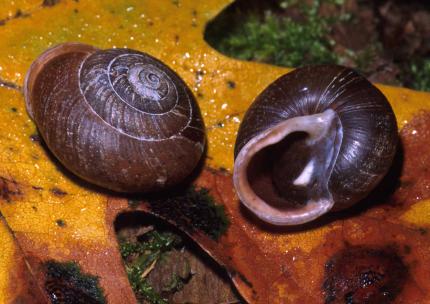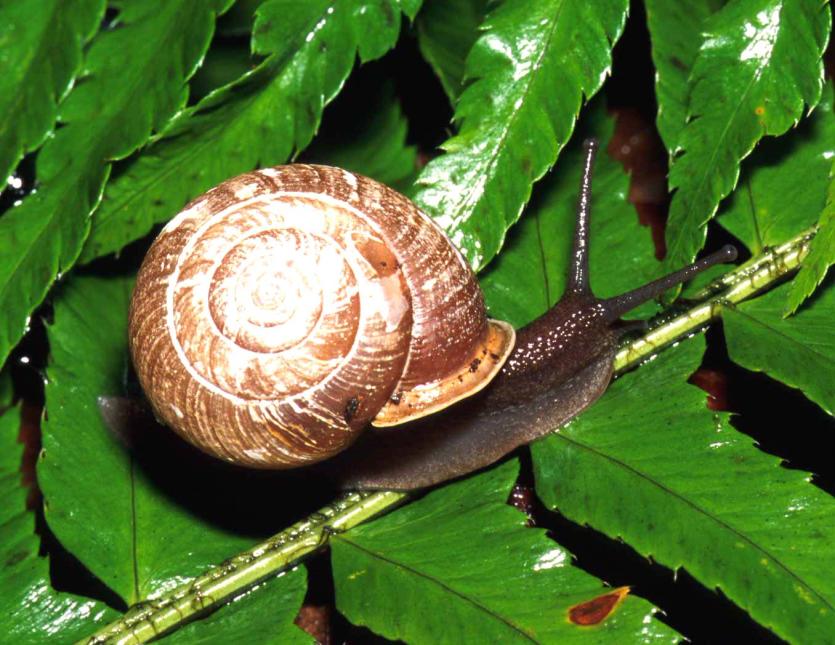Low-
Moderate
The Puget Oregonian's population size is low and has a declining trend. These snails are in the Family Polygyridae. Snails in this family are of conservation concern because they have specialized habitat requirements. Snails do not readily disperse and populations are isolated. They are vulnerable to alteration of their habitat.
Description and Range
Physical description
The Cryptomastix species are medium to moderately large Pacific Northwest native species. Snails in the Cryptomastix genus are medium to moderately large Pacific Northwest native species. The Puget Oregonian is significantly larger than any other species in the genus and can be easily distinguished by its shell size. The shell measures (0.79 to 0.94 inch) 20 to 24 millimeters wide by (0.47 to 0.63 inches) 12 to 16 millimeters tall, with about 6 whorls, and is medium to dark brown in color. A whorl is the part of the shell that is one 360-degree section of the spiral. The shell lip is white and slightly recurved.

Ecology and life history
The Puget Oregonian is most commonly found in moist coniferous forests, often occurring within riparian areas and seeps and springs. It is strongly associated with large bigleaf maples, often interspersed with native conifer trees or groves of maple and other deciduous forest, as well as sword ferns. Within these forests, the snail is found under and among leaf litter, woody debris, mosses, and on the lower trunks of bigleaf maple. They may also be found under rocks, and young snails may be found under mosses.
Puget Oregonians are assumed to live several years. However, specific details on life span and reproduction for this species are not known. Like most terrestrial gastropods, Cryptomastix are hermaphroditic, having both male and female organs.
Eggs are likely deposited under large woody debris, under sword fern or soil near maples. After hatching, juveniles disperse through suitable habitat.
Polygyrids are generally herbivorous and fungivorous snails. It is suggested that the Puget Oregonian (C. devia) might aid in the dispersal of fungal spores, including mycorrhizal fungi that form tree-root associations which promote healthy tree growth.
Geographic range
The Puget Oregonian is found in the western Cascade Range and Puget Trough from southern Vancouver Island, B.C. through western Washington to the Oregon side of the Columbia Gorge. Records exist from Clark, Cowlitz, King, Lewis, Pierce, Skamania, and Thurston Counties, Washington. It is currently considered extirpated from British Columbia. Scientists noted 178 locations, but at most sites only one to three snails were found. Most sites are in Gifford Pinchot National Forest, where it is relatively common only in the Cowlitz and Cispus River drainages; elsewhere it is quite rare and local.
Climate vulnerability
Sensitivity to climate change
Low
There is limited information on the Puget Oregonian snail to climate change. This species is found in cool, moist conifer forests at low to moderate elevations, especially under large woody debris and leaf litter. This shade provides refugia from moderate fluctuations in temperature and moisture; changes in canopy cover may therefore negatively impact this species.
Exposure to climate change
Moderate
- Increased temperatures
- Reduced soil moisture and/or drought
- Altered fire regimes
Conservation
Conservation Threats and Actions Needed
- Resource information collection needs
- Threat: Status assessment is insufficient.
- Action Needed: Improve status assessment.
- Fish and wildlife habitat loss or degradation.
- Threat: Habitat loss due to urbanization.
- Action Needed: Management recommendations; technical assistance.
- Agriculture and aquaculture side effects
- Threat: Habitat loss due to logging of old-growth forest and bigleaf maple.
- Action Needed: Management recommendations: technical assistance.
This species' climate vulnerability is assessed as "low to moderate." Climate vulnerability (PDF) is a way to assess the degree to which a habitat or species is susceptible to, and unable to cope with adverse impacts of climate change.
Resources
References
Applegarth, J. S. 1999. Management Recommendations for Cryptomastix hendersoni, the Columbia Oregonian (land snail) v.20, Section 2, in T. E. Burke, J.S. Applegarth, and T. R. Weasma. Management Recommendations for Survey and Manage Terrestrial Mollusks (v. 2). USFS and BLM.
Burke, T. E. 2013. Land Snails and Slugs of the Pacific Northwest. Oregon State University Press, Corvallis, OR. 344 pp.
Burke, T., J. Applegarth, T. Weasma, and N. Duncan. 1999. Management recommendations for Survey and Manage terrestrial mollusks, ver. 2.0. USDA Forest Service, USDI Bureau of Land Management. Available online at http://www.or.blm.gov/surveyandmanage/MR/TM23Species/m2000-003.htm
COSEWIC. 2013. COSEWIC assessment and status report on the Oregon Forestsnail Allogona townsendiana in Canada. Committee on the Status of Endangered Wildlife in Canada. Ottawa. xii + 87pp. (www.registrelep-sararegistry.gc.ca/default_e.cfm).
Duncan, N. 2009. Vespericola columbianus depressa. Species Fact Sheet. Interagency Special Status/Sensitive Species Program, Forest Service, Bureau of Land Management.
Edworthy, A., K. Steensma, H. Zandberg, and P. Lilley. 2012. Dispersal, home range size and habitat use of an endangered land snail, the Oregon Forestsnail (Allogona townsendiana). Canadian Journal of Zoology 90(7):875–884.
Foltz Jordan, S., S.H. Black. 2015. Conservation Assessment for Cryptomastix devia, Puget Oregonian. USDA 2028 Forest Service Region 6 and USDI Bureau of Land Management. Portland, OR. pp. 32.
Frest, T. J., and E. J. Johannes. 1995. Interior Columbia Basin Mollusk Species of Special Concern. Final Report, Deixis Consultants, Seattle. Prepared for Interior Columbia Basin Ecosystem Management Project, Walla Walla, WA 362 pp.
Steensma, K. M. M., L. P. Lilley, and H. M. Zandberg. 2009. Life history and habitat requirements of the Oregon forestsnail, Allogona townsendiana (Mollusca, Gastropoda, Pulmonata, Polygyridae), in a British Columbia population. Invertebrate Biology 128:232–242.
USFWS. 2011. Endangered and Threatened Wildlife and Plants: 90-day finding on a petition to list 29 mollusk species as threatened or endangered with critical habitat: proposed rule. Federal Register 76 (No. 193, October 5, 2011): 61826-61853.
